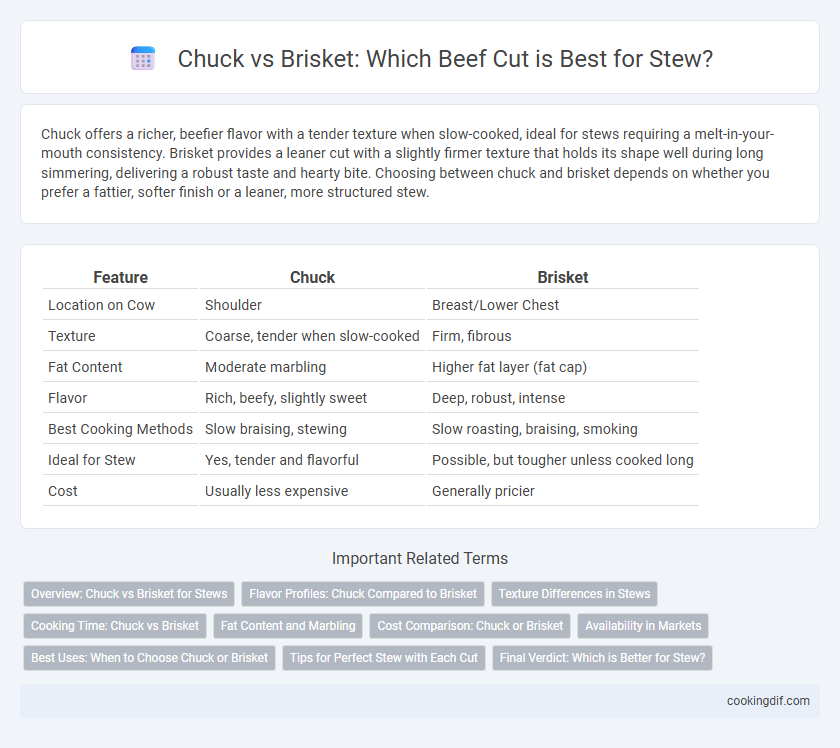Chuck offers a richer, beefier flavor with a tender texture when slow-cooked, ideal for stews requiring a melt-in-your-mouth consistency. Brisket provides a leaner cut with a slightly firmer texture that holds its shape well during long simmering, delivering a robust taste and hearty bite. Choosing between chuck and brisket depends on whether you prefer a fattier, softer finish or a leaner, more structured stew.
Table of Comparison
| Feature | Chuck | Brisket |
|---|---|---|
| Location on Cow | Shoulder | Breast/Lower Chest |
| Texture | Coarse, tender when slow-cooked | Firm, fibrous |
| Fat Content | Moderate marbling | Higher fat layer (fat cap) |
| Flavor | Rich, beefy, slightly sweet | Deep, robust, intense |
| Best Cooking Methods | Slow braising, stewing | Slow roasting, braising, smoking |
| Ideal for Stew | Yes, tender and flavorful | Possible, but tougher unless cooked long |
| Cost | Usually less expensive | Generally pricier |
Overview: Chuck vs Brisket for Stews
Chuck offers a well-marbled texture with rich fat content, making it ideal for stews due to its tenderness and ability to break down into flavorful, succulent meat. Brisket, while leaner and tougher, requires longer cooking times but delivers a deep, beefy flavor and a denser texture that holds up well in slow-simmered stews. Choosing between chuck and brisket depends on the desired stew consistency and cooking duration, with chuck favored for faster tenderness and brisket for a heartier bite.
Flavor Profiles: Chuck Compared to Brisket
Chuck offers a rich, beefy flavor with a moderate amount of marbling that melts into the stew, enhancing juiciness and depth. Brisket delivers a slightly sweeter, more intense taste with a denser texture due to its tighter grain and higher collagen content. When slow-cooked, chuck breaks down more evenly, creating a tender, savory profile, while brisket adds a robust, smoky undertone ideal for hearty stews.
Texture Differences in Stews
Chuck offers a rich, marbled texture that becomes tender and juicy when slow-cooked in stews, creating a hearty mouthfeel. Brisket, with its coarser grain and higher connective tissue, breaks down into a stringy, fibrous texture that adds depth and a chewy quality to the stew. Choosing chuck results in a smoother, melt-in-your-mouth experience, while brisket provides a more pronounced, rustic bite that holds up well to long braising.
Cooking Time: Chuck vs Brisket
Chuck requires a shorter cooking time compared to brisket, typically needing about 2 to 3 hours to become tender when slow-cooked in a stew. Brisket demands a longer cooking period, often 3 to 4 hours or more, to break down its dense connective tissues thoroughly. Properly timed cooking enhances the rich, beefy flavors and achieves optimal tenderness in both cuts.
Fat Content and Marbling
Brisket typically has higher fat content and more extensive marbling compared to chuck, making it richer and more flavorful in stews. The intramuscular fat in brisket melts slowly during long cooking, enhancing tenderness and imparting a succulent texture. Chuck, while leaner, contains moderate marbling that offers a balanced flavor and firmness ideal for hearty stew chunks.
Cost Comparison: Chuck or Brisket
Chuck is typically more budget-friendly than brisket, making it a popular choice for cost-conscious stews. Brisket tends to be pricier due to its demand and specific texture qualities, which can impact the overall budget of stew preparation. When comparing price per pound, chuck offers excellent value without sacrificing flavor or tenderness in long, slow-cooked dishes.
Availability in Markets
Chuck is widely available in most supermarkets year-round, making it a practical choice for stew recipes that require a budget-friendly yet flavorful beef cut. Brisket, while also common, tends to be less consistently stocked in smaller grocery stores and often reserved for specialty cuts or holiday sales. Availability of brisket can vary significantly by region, with higher demand in areas known for barbecue traditions.
Best Uses: When to Choose Chuck or Brisket
Chuck is ideal for stews requiring rich, flavorful meat that becomes tender with slow cooking, making it perfect for long braises or slow-cooked pots. Brisket excels in recipes needing a firmer texture and deep beefy flavor after extended cooking times, often preferred for braised or smoked dishes. Choose chuck for softer, melt-in-your-mouth stews, while brisket suits hearty recipes where sliceable meat is desired.
Tips for Perfect Stew with Each Cut
Choosing chuck for stew ensures a rich, tender texture due to its higher fat content and marbling, which breaks down beautifully during slow cooking. Brisket offers a slightly leaner option with a distinctive beefy flavor, benefiting from extended simmering times to achieve optimal tenderness. To perfect stew with chuck, sear the meat well before slow cooking, while with brisket, trimming excess fat and simmering gently prevents toughness and promotes a succulent finish.
Final Verdict: Which is Better for Stew?
Chuck is widely favored for stew due to its rich marbling and connective tissue that breaks down during slow cooking, resulting in tender, flavorful meat. Brisket can be used but often requires longer cooking times to achieve the same tenderness and may have a denser texture that some find less appealing in stew. Overall, chuck offers a better balance of taste, texture, and ease of preparation, making it the preferred cut for most stew recipes.
Chuck vs Brisket for beef cut Infographic

 cookingdif.com
cookingdif.com